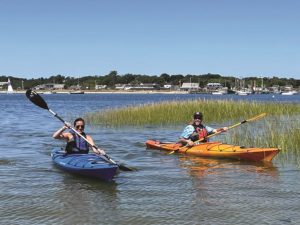I’ve seen them, in couples and small groups, gliding low on the water in brightly colored boats. It looks like fun, and it’s got to be a great way to explore the waterways of the Outer Cape. As I watch paddlers move, I can see that it offers a low-stress workout with a focus on the chest, back, and core. I’m not one of them — at least not yet. But I’ve long wanted to take a closer look and consider what it might be like to take up kayaking.

Keith and Eloise MacLelland, who live in Wellfleet, head out onto the water together often. When I ask what it’s like to be kayakers, they don’t talk much about the exercise value of the sport. They’re motivated more by the fact that it gives them a way to connect with nature and each other.
Eloise, an English language arts teacher at Nauset Middle School, appreciates the way it allows her to find a quiet place. During the summer, she says, just being out for an hour or two feels like a vacation and an escape from the crowds, too. She describes kayaking as an “easy adventure” that over the last 20 years has taken her into the ocean, ponds, bays, and rivers — including the Charles. Even in Boston, next to the highway, she says, in her kayak she was able to find peace on the water.
Keith, an artist, loves the accessibility of kayaking. It doesn’t require a huge investment, he says, at least once you purchase your boat, life jacket, and paddle; there are no fees, or signing up for times, or waiting in line. You can take your boat anywhere. It’s also easy to get started, in terms of skills — there aren’t a lot of complicated moves to learn.
Sometimes Keith goes out alone, puttering along the edges of the ponds picking up trash. He and Eloise both like that when they’re paddling the only energy they’re burning is their own. They try to tread lightly, noting it’s important not to put in or store your kayak on fragile coastal banks, where crushing the vegetation can add to erosion.
Most times, they go out together, finding that one person’s enthusiasm inspires the other to get moving. And they both say having a shared experience outside of the routines of work and home provides a chance to connect as a couple.
Eloise and Keith are on to something: studies show that couples who exercise together report more enjoyment of the activity and more elevation in mood afterwards than people who go it alone. The theory is that it has something to do with the feeling of social and emotional support, similar to going to a class. It seems to me a good idea to have a kayaking partner, for safety’s sake, too.
For first-timers, other safety tips include: Make sure you have a personal flotation device, for starters. Get comfortable in the shallow water before you venture out further. Do a little bit of reading before you go, to learn how to get in and out safely and what to do if you tip over. Consider doing a guided tour or a lesson to learn the basics.
Whether you’re new at kayaking or not, here are two warm-ups to be sure the core and posture muscles are engaging before you get into the boat:
- Paddle pull-downs activate the muscles of the upper back that help you sit up straight on that little seat. Hold the paddle crosswise in front of you, with hands wider than shoulder width, palms down. Raise the paddle overhead, then lower it to chest height as you squeeze your shoulder blades together. Repeat slowly 8 to 12 times.
- The one-leg dead lift is similar to the Warrior 3 pose in yoga. I sometimes refer to it as the drinking bird (remember that toy? when the beak went in the water the tail lifted up). This will stretch the hamstrings, which will help with the sitting position in the boat, as well as get the core muscles firing. Stand tall on your right foot, near your tailgate, a fence, tree, or anything you can touch for balance. Extend your left leg straight back, pull your belly button in, and slowly lower your head and chest, while raising the left leg behind you until you feel a stretch on the back of the right thigh. Hang onto your support for balance as needed. Switch legs, doing 5 to 8 times on each leg.



